Restaurants projected to add 525k seasonal jobs this summer
Summer is the busiest season for restaurants in many parts of the country, and the stronger business leads to additional employment opportunities at all levels of a restaurant operation. These summer jobs are typically filled by a wide variety of individuals – teenagers, college students, teachers – even retirees who want to pick up a few shifts at the 19th hole of their local golf course.
Restaurants are expected to add 525,000 seasonal jobs this summer, according to the National Restaurant Association’s 26th annual Eating and Drinking Place Summer Employment Forecast.
That would be down slightly from last summer, when eating and drinking places added 552,000 seasonal jobs. The 2023 season ranked only behind 2015’s 555,000 summer jobs as the strongest seasonal hiring on record.
While the 2024 summer employment projection is down somewhat from 2023, it would represent the second consecutive year in which eating and drinking places added at least 525,000 seasonal jobs – the first such occurrence on record. This is largely because teenagers and young adults – the age cohorts most likely to work seasonal jobs – are returning to the labor force in numbers not seen in years. (More details below.)
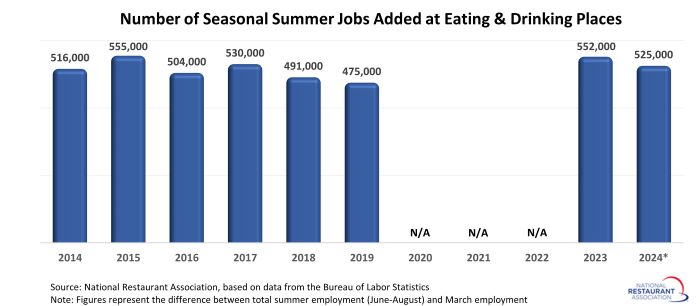
[Note: The 2020 – 2022 summers are excluded from the chart above because they were not typical hiring seasons. After losing millions of jobs during the early months of the pandemic, restaurants were still working to rebuild their teams back to pre-pandemic levels. As a result, it was not possible to distinguish between pandemic recovery and seasonal hiring during those three summers.]
Northeastern states will see the strongest summer job growth
Seasonal hiring varies significantly by state and is influenced by weather changes as well as the reliance on summer travel and tourism. For these reasons, states in the northeast typically see the strongest growth in restaurant jobs during the summer months.
The states projected to register the largest proportional employment increase during the 2024 summer season are Maine (32%), Alaska (21%), Delaware (17%), Rhode Island (17%), New Hampshire (13%), New Jersey (12%) and Massachusetts (12%).
The states projected to add the most eating and drinking place jobs during the 2024 summer season are New York (48,600), California (41,600), Texas (35,000), New Jersey (33,400), Massachusetts (30,000), Michigan (23,300), Illinois (23,200), Ohio (21,800), Maryland (19,900) and North Carolina (19,000).
Due to the fact that their busiest seasons for travel and tourism are not in the summer months, Florida (-8,800) and Arizona (-3,100) are projected to register declines in eating and drinking place employment during the 2024 summer season.
View the summer employment forecast for every state.
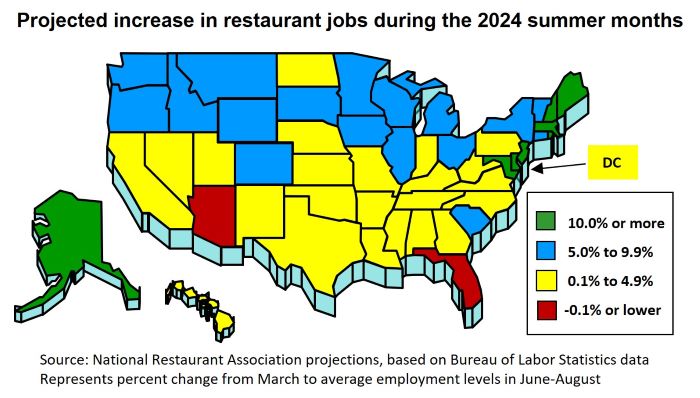
Prime labor pool is getting deeper
As the 2024 summer season approached, the restaurant industry’s prime labor pool was at an elevated level compared to recent years. More than 6.2 million 16-19 year olds were in the labor force in April, according to the Bureau of Labor Statistics (BLS). That was 900,000 higher than the comparable pre-pandemic level in April 2019, and represented the highest April reading since 2008 (6.5 million).
That number will rise well above 7 million during the peak summer months when more students are available, but the early workforce arrival of many teenagers likely helped some restaurants get a jump on their summer hiring.
The recent upward trend of teens in the workforce is a positive sign for restaurants, as this cohort makes up 21% of the industry workforce. Overall, restaurants are the economy’s largest employer of teenagers, providing job opportunities for nearly 2 million 16-19 year olds – or 35% of all working teens.
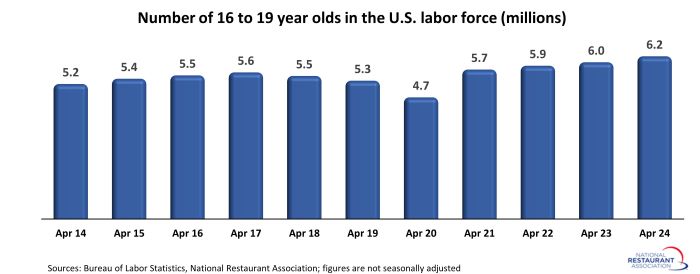
Restaurants are the economy’s second largest employer of 20-24 year olds (retail is #1). Nearly 2 million 20-24 year olds work at eating and drinking places, accounting for 21% of the sector’s workforce.
There were 15.2 million 20-24 year olds in the labor force in April 2024, which was down slightly from last April’s decades-high reading of 15.4 million (the highest since 1984). Despite the downtick, there are still more young adults in the labor pool than there were in the years leading up to the pandemic.
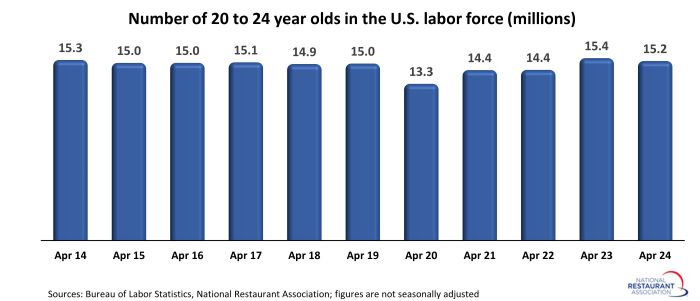
Restaurant operators looking for a more experienced team this summer are also in luck, as the number of older adults in the labor pool continues to rise. There were 11.4 million adults aged 65 or older in the labor force in April 2024, according to BLS. That was up from 10.4 million in April 2019 and represented the highest April reading on record.
Although this age group makes up just 3% of the overall restaurant workforce, it will potentially become more important in the coming years as their representation in the labor pool continues to rise. By 2032, BLS predicts there will be 14.6 million adults aged 65 or older in the labor force – an increase of more than 3 million above current levels.
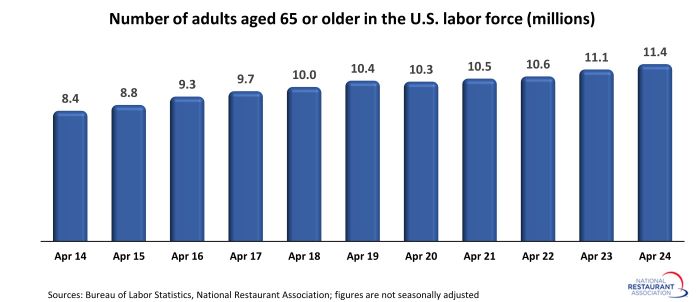
Notes about the 2024 Eating and Drinking Place Summer Employment Forecast:
- Eating and drinking places are the primary component of the restaurant and foodservice industry, which the National Restaurant Association defines as that which encompasses all meals and snacks prepared away from home. Eating and drinking places account for approximately three-fourths of the total restaurant and foodservice workforce.
- Summer employment is defined as the average number of eating and drinking place jobs in June, July and August.
- The number of summer jobs is the difference between the projected total 2024 summer employment and the March 2024 employment level.
- Generally, the U.S. restaurant industry begins to ramp up its summer seasonal hiring in April, and it peaks in June, July and August.
- The restaurant industry is typically the nation’s second largest creator of seasonal jobs during the summer months – ranking only behind the construction industry.
Read more analysis and commentary from the Association's economists, including the latest outlook for consumers and the economy.